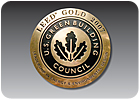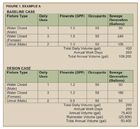
Many of us have heard of LEED, but what is it exactly? LEED stands for Leadership in Energy and Environmental Design, and it is a rating system developed by the U.S. Green Building Council (USGBC) in 1998. The purpose of LEED is to make buildings more efficient and sustainable than the maximum required levels. (In this article, I will not differentiate between new or existing construction. It should be clear which features will be easiest to implement in the type of building you are evaluating or designing.)
The LEED rating system provides a point system scorecard to evaluate the environmental performance from a whole building perspective (non-residential). The rating system is organized into five environmental categories: Sustainable Sites, Water Efficiency, Energy & Atmosphere, Materials & Resources and Indoor Environmental Quality. For the purpose of our discussion, we will be focusing on Water Efficiency.
The Water Efficiency (WE) category of the LEED rating system is the least emphasized, with a potential of three LEED points obtainable through Innovative Waste Water Technologies and Water Use Reduction. The LEED rating system for Water Use Reduction is based on the U.S. Energy Policy Act of 1992, which set maximum plumbing-fixture flow rates (see below) and serves as a basis to evaluate sustainable features in a non-residential building.

Innovative Waste Water Technologies
Innovative Waste Water TechnologiesWE Credit 2(worth 1 LEED point)
• Based on LEED-NC Version 2.2 Reference Guide
• Intent-To reduce generation of wastewater and potable water demand, while increasing the local aquifer recharge.
• Requirements:
Option 1
Reduce potable water use for building sewage conveyance by 50% through the use of water-conserving fixtures (water closets and urinals) or non-potable water (captured rainwater, recycled graywater and on-site or municipally treated wastewater).
Option 2
Treat 50% of wastewater on-site to tertiary standards. Treated water must be filtered or used on-site.
My experience is that the collection of rainwater is a fairly straightforward method of obtaining this credit point. For use in the plumbing system, I recommend the collection of rainwater from the roof rather than parking lots, which contain oils and other hazardous waste contaminants that are more difficult to filter and handle for disposal. The collection of rainwater requires the rainwater drainage system be collected and piped to a collection tank(s) that is either underground or above ground.
In most cases, the rainwater is pumped from the collection tank through a series of filters (5 micron to collect the large particles and 50 micron to collect any other solids) and then passed through a UV sterilizer to kill any bacteria. The collected rainwater is now ready to be used to flush the water closets and urinals. Keep in mind this is non-potable water and should be treated as such.
In my designs, I provide a backup connection to the potable water system in the building in the event no rainwater is available. The backup connection of potable water is protected by a reduced-pressure backflow device to protect the building’s potable water system from the cross-connected reclaimed rainwater. This system is typically designed for new construction, since an existing building retrofit would be cost prohibitive.

Figure 1
The baseline case flow rates use the maximum flow rates based on the U.S. Energy Policy Act of 1992. Using a combination of water-conserving fixtures and rainwater collection, the design case building indicates a 54% reduction in potable water volume used for sewage conveyance; this, therefore, qualifies for the one point credit.
While the reduction of wastewater by use of rainwater is achievable, the easier method of wastewater reduction-as well as overall water use reduction-is the application of water-efficient fixtures.

Water Use Reduction
We will now look at the two available LEED credits for water use reduction.WE Credit 3.1(20% reduction; worth 1 LEED point)
• Based on LEED-NC Version 2.2 Reference Guide
• Intent-To maximize water efficiency within buildings to reduce the burden on municipal water supply and waste water systems.
• Requirements-Employ strategies that in aggregate use 20% less water than the water use baseline calculated for the building (not including irrigation) after meeting the Energy Policy Act of 1992 fixture-performance requirements. Calculation is based on estimated occupant usage and shall include only the following fixtures as applicable to the non-residential building: water closets, urinals, lavatory faucets, showers and kitchen sinks.

• Based on LEED-NC Version 2.2 Reference Guide
Note: This credit employs the same requirements as above, except it seeks 10% more efficiency.
It has been my experience that water-saving methods of employing water-efficient fixtures are both easy and cost-effective for both new and retrofit construction. My standard designs employ all the requirements to comply with and achieve these LEED credits.
We can use the same potable-water calculations of Example A to demonstrate just how easy it is to be sustainable and water efficient at no additional cost. Remember, these calculations are for a non-residential building with an occupant capacity of 100 people (50 males and 50 females). The calculation (Example B; seeFigure 2) is based on a typical 8-hour workday. Male occupants are assumed to use water closets once and urinals twice a day. Female occupants are assumed to use water closets three times a day.
As with Example A, the baseline case flow rates use the maximum flow rates based on the U.S. Energy Policy Act of 1992. Using a combination of water-conserving fixtures, the design case building indicates a 48% reduction in potable water volume. This, therefore, qualifies for the one point credit for the 20% reduction-plus an additional one point for exceeding the 30% water use reduction, for a total of two LEED points.
What makes this so simple is the fact that standard fixtures are available from all the major fixture manufacturers to meet these criteria. If we only used a 0.5-gpf urinal and water-saving metering faucets on the lavatories, we would still realize a 35% water reduction without changing the water closets.

Extra Points
The LEED point system also allows for Innovative & Design Process points (maximum of four). These allow the designer to submit to the USGBC an innovative design concept that might not be covered within the existing point structure, such as Press-Fit copper piping or CSST gas piping. These systems may qualify for an innovative credit point because they use recyclable materials and are solderless and oil-less, which is environmentally friendly.Another misconception being sold by some manufacturers, or their representatives, is that by using a specific fixture you will automatically get a LEED point. WRONG! A specific fixture will contribute to obtaining LEED points; however, as stated in the beginning of this article, LEED points are based on the total building energy efficiency, so be careful and design wisely.
Hopefully, you see that providing a sustainable plumbing design to obtain LEED-related points is fairly easy. In fact, you may already be designing to meet these requirements. Although I’ve only discussed non-residential buildings, all of these measures can be applied to residential buildings as well.